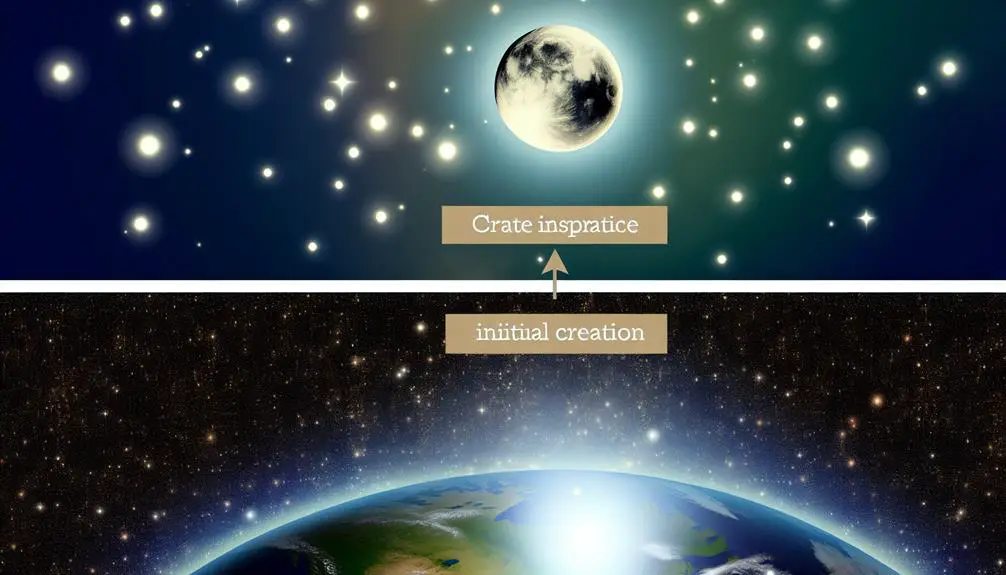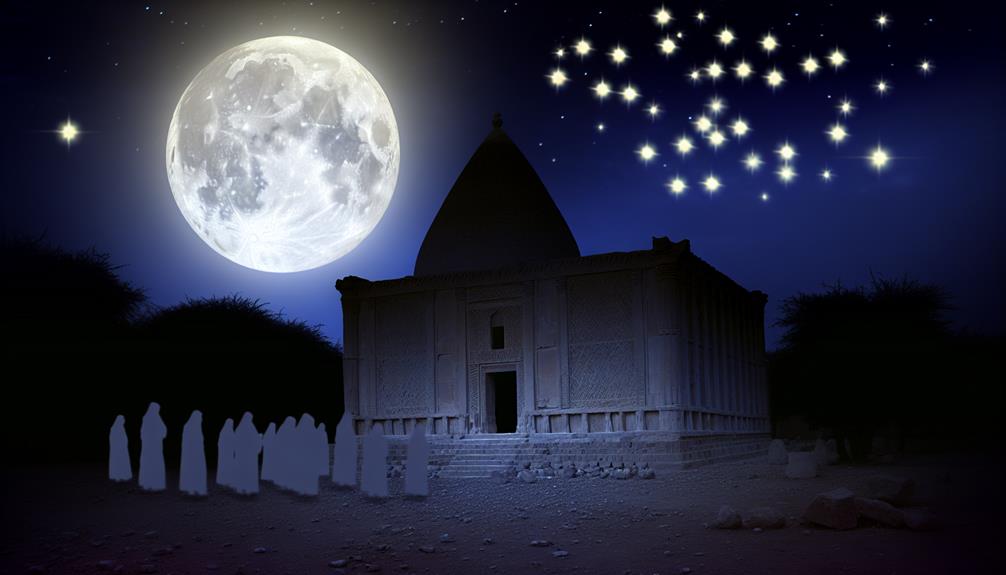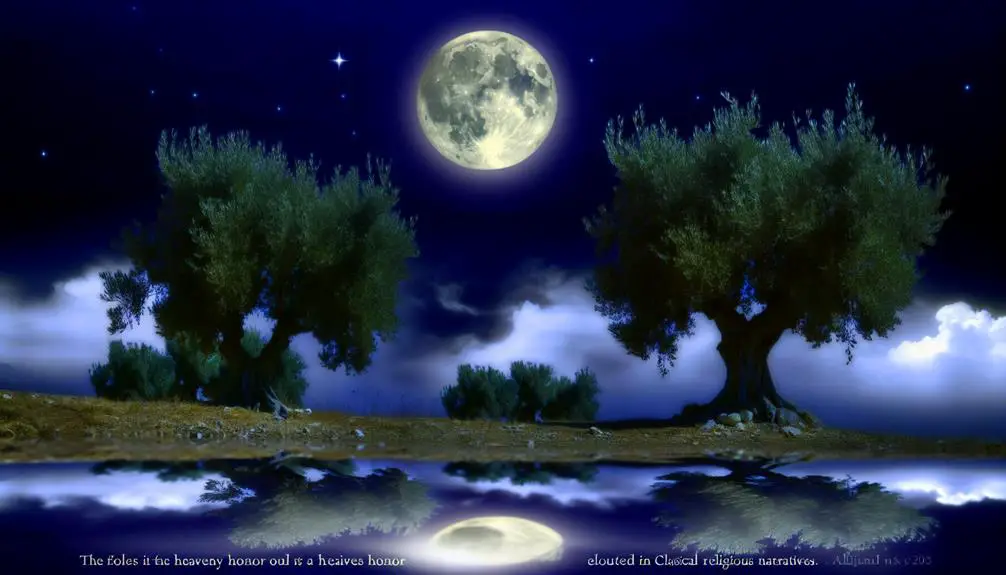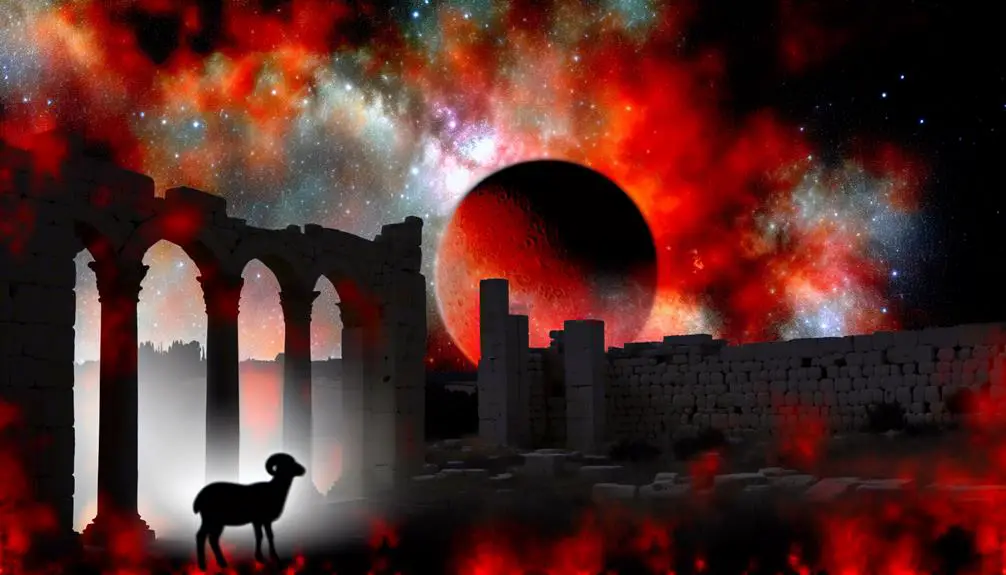See how the moon's celestial dance in the Bible reveals hidden spiritual truths and divine messages, sparking curiosity for deeper exploration.

Moon in the Bible
You might not be aware that the moon plays a more intricate role in the Bible than merely marking the passage of time. Beyond its creation in Genesis, it serves as a foundational element for festivals, a symbol within prophecies, and a sign of divine presence in poetry.
As we explore its multifaceted presence, you'll discover how lunar imagery weaves through biblical narratives, offering deeper insights into spiritual truths and the nature of God's communication with humanity. The journey ahead promises to unveil connections that enrich our understanding of celestial influence in biblical history and its implications for modern faith.
Key Takeaways
- The moon serves as a symbol of God's providence, reflecting balance, harmony, and divine intention.
- It functions as a celestial timekeeper, determining the timing of biblical festivals and seasons of renewal.
- Lunar phenomena, including eclipses, are interpreted as divine signs with theological and prophetic implications.
- Moon symbolism in the Bible underscores God's unchanging promises and faithfulness, mirrored in its phases and cycles.
The Creation Account

In the creation narrative of Genesis, God meticulously forms the cosmos, appointing the moon as a crucial celestial body to govern the night. This assignment isn't merely functional; it carries profound creation significance, reflecting God's sovereign order. The lunar brightness, distinct from the sun's radiance, serves not only to illuminate the darkness but also to symbolize the balance and harmony within creation. It's a testament to God's thoughtful design, where even the night isn't left to total darkness, but is gently lit by the moon's glow.
You'll find that this careful positioning of the moon speaks volumes about its role in the biblical understanding of the world. It's not just a physical entity; it's a marker of God's providence and attention to detail. The lunar brightness, though lesser than the sun, is perfectly suited for its time, highlighting a divine consideration for all of creation's needs. This duality of light, one for the day and one for the night, underscores the meticulous nature of God's work, where every element has a purpose, and every detail contributes to the broader tapestry of creation.
Moon as Timekeeper
Beyond its role in illuminating the night, the moon also serves as a divine timekeeper, marking seasons and guiding the observance of sacred times within the biblical narrative. You'll find that the moon's phases and lunar cycles are intricately woven into the fabric of biblical timelines and events, serving not just as celestial phenomena but as markers of divine order and rhythm.
Let's delve deeper into the significance of the moon's phases and lunar cycles:
Moon Phase |
Significance in Biblical Times |
|---|---|
New Moon |
Marked the beginning of the month; a time for renewal and worship. |
First Quarter |
Symbolized progression and the unfolding of God's plan. |
Full Moon |
Often coincided with significant festivals and events, symbolizing completion and fulfillment. |
Last Quarter |
Represented reflection, preparation for the new cycle. |
Waning Crescent |
A period of diminishing light, inviting introspection before renewal. |
These phases and cycles didn't just measure time; they were a testament to the moon's role as a divine orchestrator of seasons and sacred times. By observing the moon, you're reminded of the cyclical nature of life and the divine timing that orchestrates the universe.
Festivals and the Moon

Reflecting on the moon's phases and their significance brings us to consider how these celestial markers also determined the timing of biblical festivals. The ancient Israelites, deeply connected to both their faith and the land, relied on the moon to guide their agricultural activities and religious observances. This intimate link between moon agriculture and spirituality is evident in the scheduling of lunar holidays, which are meticulously aligned with the moon's cycles.
Passover, for instance, is celebrated on the 14th day of Nisan, a month that begins with the new moon. This timing ensures that the festival of unleavened bread coincides with the start of the barley harvest, integrating moon agriculture into the very fabric of Israelite society. Similarly, the Feast of Tabernacles falls on the 15th day of the seventh month, when the moon is full, symbolizing a time of thanksgiving at the end of the harvest season.
These festivals, deeply rooted in the rhythms of nature and the lunar calendar, not only underscore the moon's role in determining sacred times but also highlight a harmonious existence that intertwines faith, agriculture, and the cosmos. Through observing lunar holidays, the ancient Israelites celebrated the providence and faithfulness of their Creator, marking seasons of renewal, thanksgiving, and remembrance.
Lunar Eclipses and Omens
You'll find that the Bible's references to lunar eclipses often suggest they're more than mere celestial events; they're interpreted as profound divine signs.
Scholars and theologians have long debated how these occurrences were understood in biblical times, especially in the context of prophecy and divine messages.
Historical accounts of eclipses in scripture and their timing in relation to prophetic events underscore their significance in God's communication with humanity.
Biblical Interpretations of Eclipses
In the biblical context, lunar eclipses were often interpreted as significant omens, carrying profound theological and prophetic implications. This understanding bridges the gap between ancient eclipse mythology and contemporary scientific explanations. As you delve further, it becomes evident that these celestial events were not merely astronomical phenomena but were imbued with divine significance.
Aspect |
Eclipse Mythology |
Scientific Explanations |
|---|---|---|
Cause |
Divine message |
Earth's shadow |
Impact |
Sign of change |
None inherently |
Timing |
Prophetic |
Predictable |
Reaction |
Prayer, repentance |
Observation, study |
Understanding |
Supernatural |
Natural phenomena |
This analytical approach reveals how deeply intertwined celestial occurrences and theological interpretation were, challenging you to appreciate the complexity and richness of biblical references to lunar eclipses.
Eclipses as Divine Signs
Throughout history, lunar eclipses have been perceived as divine signs, signaling to humanity messages from beyond the celestial veil. This understanding bridges the gap between faith and the cosmos, intertwining astronomical accuracy with spiritual insight. Scientific analysis of these celestial events enhances our comprehension, revealing the precision of the universe's design, perceived by many as a direct communication from the divine.
- *Astronomical accuracy of lunar eclipses showcases the meticulous order of creation.*
- *Scientific analysis deepens our appreciation for these phenomena as more than mere coincidences.*
- *The awe-inspiring beauty of a blood moon evokes a profound emotional response, connecting us spiritually to the heavens.*
- *These events serve as a reminder of the greater cosmic plan, encouraging reflection and humility.*
Historical Eclipses and Prophecy
Historical records demonstrate that societies across time have interpreted lunar eclipses as prophetic omens, signaling divine messages or forewarning of significant earthly events. This perspective, deeply rooted in lunar agriculture and Moon myths, reflects an intriguing intersection between celestial phenomena and human belief systems.
You'll find that ancient civilizations, leveraging their understanding of the Moon's cycles, intricately linked lunar agriculture practices with the interpretation of eclipses, viewing them as divine indicators of bountiful harvests or impending famine. Moreover, the lore surrounding Moon myths often imbued these celestial events with a sense of foreboding, suggesting that lunar eclipses were harbingers of change or turmoil.
This confluence of agricultural reliance and mythological interpretation underscores the profound impact of lunar phenomena on historical societies, highlighting the Moon's enduring influence on human culture and faith.
Symbolism in Prophecy
The symbolism of the moon in biblical prophecy often serves as a metaphor for change, reflecting shifts in divine intention and human circumstance. Through the use of lunar metaphors and celestial dynamics, scriptures convey powerful messages about the unfolding of divine plans and the inevitable transformations within the spiritual realm and human experience. This imagery draws you into a deeper understanding of the prophetic messages, urging you to contemplate the cyclical nature of divine interventions and the transient aspects of worldly affairs.
The waxing and waning of the moon symbolize the ebb and flow of divine favor and human fortune, inviting you to trust in the constancy of God's presence through the fluctuations of life. Lunar eclipses become harbingers of significant spiritual shifts, suggesting moments of divine revelation or judgment. The contrast between the brightness of the full moon and the darkness of the new moon mirrors the contrast between periods of clarity and times of spiritual testing. The steadfast cycle of the moon reflects the unchanging nature of God's promises, reassuring you of His faithfulness amidst the changing tides of history.
This analytical exploration into the symbolism of the moon in prophecy illuminates the profound ways in which celestial phenomena have been interpreted as divine messages, deeply impacting the faith and understanding of believers.
Reflections of Divine Glory

Building on the understanding of celestial symbolism, let's explore how the moon's cycles not only signify divine interventions but also reflect the very glory of God, casting light on His majesty and grace in the lives of believers. The moon, a creation devoid of its own light, mirrors the sun's brilliance at night, serving as a potent metaphor for how humans, created in God's image, are called to reflect His glory. This celestial body, in its silent orbit, teaches a profound lesson about humility and the role of being a vessel for divine light.
Lunar worship, prevalent in ancient cultures, often missed the mark by venerating the creation rather than the Creator. Yet, the Bible redirects this admiration towards the celestial beauty of the moon as a testament to God's craftsmanship, inviting you to marvel at His creative power and sovereign control over the universe. The moon's phases, marking seasons and times, further underscore God's meticulous planning and care for His creation, reminding you of His constant presence and guidance.
In this light, the moon transcends its role as a mere celestial object, becoming a symbol of hope and a reminder of the inexhaustible glory of God that believers are called to reflect in their lives.
Moon in Psalms and Poetry
Delving into Psalms and biblical poetry, you'll find the moon frequently encapsulated as a symbol of God's enduring faithfulness and creative power. The lunar imagery isn't just an adornment but serves as a profound theological statement, woven intricately into the fabric of nighttime worship. These passages offer not just a glimpse into the ancient understanding of the cosmos but also into the heart of worship that transcends the boundaries of day and night.
- The moon, in its silent orbit, whispers of a Creator who never slumbers nor sleeps, ensuring that even in darkness, you're not forsaken.
- Its phases, a testament to the changing seasons under heaven, reflect the constancy amidst change, a metaphor for God's unchanging nature.
- The soft glow of the moonlight during nocturnal prayers serves as a reminder of God's presence, a gentle assurance in the quiet of the night.
- Lunar festivals and calendar observances, deeply rooted in biblical tradition, underline the rhythm of life governed by divine ordinance, inviting you into a dance of sacred timekeeping.
In this exploration, the moon emerges not merely as a celestial body but as a canvas displaying the majesty of God's creation, inviting you into deeper reflection and worship under the night sky.
Revelations and the End Times

ARTICLE TITLE: Moon in the Bible
PREVIOUS SUBTOPIC: 'Moon in Psalms and Poetry'
CURRENT SUBTOPIC: 'Revelations and the End Times'
Shifting our focus to the Book of Revelation, we encounter a vivid portrayal of the moon amidst prophetic visions that speak directly to the end times, offering insights into God's ultimate plan for creation. These passages suggest not just celestial disturbances but a form of moon warfare, symbolizing the cosmic battle between good and evil.
Aspect |
Description |
|---|---|
Moon Warfare |
Represents the cosmic struggle, with the moon serving as a battleground for spiritual warfare. |
Celestial Disturbances |
Signifies the upheaval of the natural order, marking the moon's role in heralding the end times. |
Symbolism |
The moon's transformation reflects the changing state of creation, aligning with God's judgment. |
Interpretation |
Encourages a deeper understanding of celestial events as metaphors for spiritual realities. |
You're invited to delve deeper into these texts, recognizing the moon's role not merely as a celestial body but as a pivotal element in the narrative of redemption and judgment. Such analysis enriches your understanding of biblical prophecy, offering a nuanced view of the end times that intertwines natural phenomena with divine purpose.
Frequently Asked Questions
How Do Different Bible Translations Vary in Their Depiction of the Moon, and What Implications Does This Have on Interpretations?
You'll find that different Bible translations employ varied translation techniques, leading to distinct lunar metaphors. These variances significantly affect interpretations, shaping how you understand celestial imagery within the text.
For example, some translations might emphasize the moon's role as a symbol of regularity and divine order, while others highlight its beauty and reflectiveness. This diversity in depiction opens up a broad spectrum of theological and philosophical reflections, enriching your faith journey.
What Are the Historical and Cultural Contexts Behind the Biblical Authors' References to the Moon, Beyond Its Religious Significance?
You're exploring the historical and cultural contexts behind lunar references. These don't just stem from religious significance. Lunar festivals and agricultural cycles played a crucial role.
Ancient peoples organized their lives around the moon's phases, dictating planting and harvesting times. This deep connection influenced how they viewed the moon, embedding it into their cultural and religious practices.
Understanding this background gives you a richer insight into the broader implications of lunar references.
Are There Any Biblical Figures Who Are Directly Associated With the Moon, and How Does This Association Affect Their Stories or Symbolism?
You're exploring how certain figures are linked to the moon, delving into Moon festivals and Lunar symbolism. This connection isn't just about celestial bodies; it's deeply rooted in their narratives, affecting their symbolism and roles within stories.
How Has the Understanding and Significance of the Moon in the Bible Evolved Among Different Christian Denominations Over Time?
Your curiosity about the moon's evolving role across Christian denominations delves into a rich tapestry of tradition and theology. Lunar festivals and the celestial hierarchy, pivotal to understanding this shift, highlight the nuanced perspectives held within different faith communities.
Analyzing these elements, you uncover a scholarly, faith-informed exploration of how interpretations and significances have transformed, weaving a complex narrative of unity and divergence in the spiritual skyline.
What Connections, if Any, Does the Bible Make Between the Moon and the Health or Wellbeing of Individuals or Communities?
You're exploring how lunar phenomena, specifically lunar eclipses and moon phases, might relate to health or wellbeing. While not directly tied to personal health in a modern scientific sense, these celestial events often symbolize change or signal divine messages in historical texts.
Analyzing these connections, you'll find that interpretations vary widely, reflecting diverse scholarly and faith-informed perspectives. It's about understanding these symbols' deeper meanings within a community's shared beliefs and experiences.
Conclusion
In your journey through the scriptures, you've seen the moon, not just as a celestial body, but as a divine instrument. From marking time and guiding festivals to serving as a symbol in prophecy and poetry, its presence weaves a tapestry of divine narrative.
As you reflect on its role in Revelations and the end times, consider the moon's glow, a reflection of God's glory, illuminating the path of the faithful. It stands as a testament to the Creator's design, a beacon in the night sky, guiding humanity through the ages.



Sign up